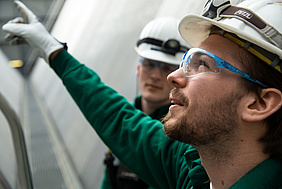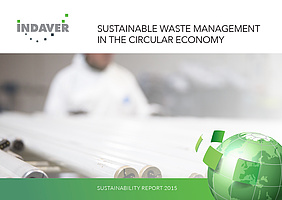Indaver helps keep our planet habitable
Raw materials
In order to keep our planet clean and safe, the way we live, produce and consume needs to be sustainable and remain so. Sufficient raw materials need to be left available which means we must use them sparingly. Indaver aims to maximise the recovery of materials that can be used as raw materials in all its operations and facilities. In 2015 we recovered 1.2 million tonnes of materials from the 5 million tonnes of waste we managed.
Innovative facilities
Indaver continuously improves its treatment facilities in order to further enhance material recovery. In 2015, Indaver Relight in Doel commissioned its new IndaTube facility. This plant, a fine example of a closed loop, now recovers fluorescence powder, lime glass and the metal caps even more efficiently for re-use. In the Netherlands, Bio Power Alphen in Alphen aan den Rijn was officially opened. An innovative digester that ferments and composts, this facility enables us to recover 4 raw materials: compost, biomass, green gas and liquid CO2.
Indaver Molecule Management receives award
Although glass, paper and plastics are now widely recycled, it is more difficult to process hazardous waste flows. With its Indaver Molecule Management®, we are working with the smallest building blocks of chemical and pharmaceutical waste, namely molecules, recovering them safely. In 2015, Indaver Molecule Management® in Belgium received the FEBEM award in the ‘best innovation or environmental project’ category.
Energy for 255,000 households
Indaver uses the heat released by thermal treatment of residual waste itself and feeds it into grids for district heating, electric power grids or other businesses. This is the annual equivalent of the energy needs of 255,000 households. We are also looking for new ways of disposing of the energy we recover. One possibility is energy clusters. In 2015 six companies from the chemical and logistics sector in the Waasland Port near Antwerp, Belgium, signed letters of intent to be supplied with green heat by the ECLUSE steam grid into which Indaver feeds heat. ECLUSE is thus set to become one of the largest industrial heat grids in Europe.
Limiting environmental footprint
We invest in advanced technologies to limit the impact of our operations on the atmosphere, water and soil. Our Sustainability Report contains a summary of the measurement results from our facilities. We use water and energy sparingly and make every effort to consume the least possible amount of raw materials, and to replace valuable raw materials with others or with waste. We limit our environmental footprint when transporting waste and treating it. In Hamburg we are involved in a large-scale programme to limit CO2 emissions. In the Netherlands we are making efforts to reduce our footprint transparently via the CO2 Performance Ladder.
Protecting materials cycle
‘Safe sinks’, i.e. safe storage facilities for undesirable substances, are required when harmful or hazardous components in waste cannot be recycled. . Indaver safely stores potentially hazardous components in high-tech final treatment facilities and thus removes them from the materials chain. The physicochemical facilities at Indaver’s site in Antwerp treat industrial, liquid and solid inorganic waste. In 2015 these facilities were rebranded: IndaChem Liquids and IndaChem Solids.
Sustainability Report
The 2015 Sustainability Report can be viewed in PDF format on Indaver’s corporate website. This PDF document is interactive: readers can click to navigate it, follow external links or go to Indaver’s regional websites.
Share this page


